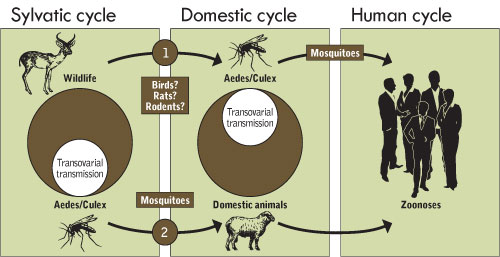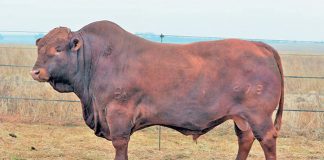Rift Valley fever (RVF) is a disease caused by a virus of the Bunyaviridae family. It is spread by the bite of infected mosquitoes and occurs worldwide. Although only one serotype – or kind – is recognised, there are various strains that cause differing severity of infection.
What species are susceptible?
RVF infects many species of animals, some worse than others.
- Extremely susceptible: lambs, kids, puppies, kittens, mice and hamsters. Mortality rate is 70% to 100%.
- Highly susceptible: sheep and calves. Mortality rate is 20% to 70%.
- Moderately susceptible: cattle, goats, African buffalo, domestic buffalo and humans. Mortality rate less than 10%.
- Resistant: camels, equids (horses, donkeys and zebras), pigs, dogs, cats, African monkeys, baboons, rabbits and guinea pigs.
Birds, reptiles and amphibians are not susceptible to RVF.
What is the impact of RVF?
The disease often results in significant economic losses due to deaths and abortions among infected livestock.
Sheep appear to be more susceptible than cattle or goats. More than 90% of lambs infected with RVF die, and abortion rates among infected pregnant ewes is almost 100%. However, mortality among adult sheep can be as low as 10%.
RVF is a zoonotic disease which is highly contagious in humans, causing fever and flu-like symptoms. In more severe cases, it may cause encephalitis – an acute inflammation of the brain – blindness or even death.
How is it transmitted?
RVF is transmitted among animals and humans by mosquitoes, especially the ‘floodwater’ breeding Aedes mosquito. It can also be transmitted to humans through direct contact with body fluids and aerosols of infected animals during slaughter, necropsy or laboratory procedures. No human- to-human transmission of RVF has been shown. Drinking raw milk from infected animals may also present a transmission risk. Given the high concentration of RVF virus in the blood of infected animals, it is highly likely that infection can be transferred between animals if the same needle is used during vaccination or bleeding.
Where does RVF occur?
The disease is endemic to the tropical regions of East and Southern Africa, and extensive outbreaks have occurred here. Across these regions, outbreaks occur in five- to 20-year cycles; in the dry semi-arid zones of East Africa, they take place every 15 to 30 years. Epidemics have been recorded in Egypt (1977/1978 and 1993), Mauritania (1987), Madagascar (1990/1991), Kenya and Somalia (1997) and South Africa (1974/1975). In 2000, RVF was recognised for the first time outside Africa, with outbreaks reported in Saudi Arabia and Yemen. From late 2008 until 2011 an extensive outbreak occurred across a large part of South Africa.

The cycles of RVF transmission. Source: FAO
What conditions lead to outbreaks?
Particularly heavy, prolonged and unseasonal rain (not simply a localised heavy rainfall) usually causes an increase in the breeding of mosquito vectors. If large numbers of first-generation transovarially infected mosquitoes emerge at the same time, an outbreak of RVF is likely to occur.
The transovarially infected female mosquitoes lay their infected eggs in grasses and mud at the edge of wetlands and floodplains. The eggs require a drying-out period and then re-wetting before they hatch. After the infected eggs have hatched, and the infected adult Aedine mosquitoes emerge, they can transmit RVF to ruminants. The mosquitoes then act as secondary vectors to sustain the epidemic.
Under optimal rainfall conditions, the life-cycle of the mosquitoes last between 14 and 21 days. Under less ideal environmental conditions, the eggs may enter a dormant state lasting several decades, hatching only when favourable weather conditions return. In the next issue, we will deal with symptoms, incubation period, diagnosis and control of RVF.
Fast facts
- Vector: the agent that carries and spreads a disease.
- Transovarial infection: when a vector passes on the disease-causing bacteria to its offspring.
- Aerosol: breath, tiny particles of matter, or germs that float in the air (a cloud is an aerosol)
- Zoonosis: a disease that can be transmitted from animals to humans.
For more information, contact Onderstepoort Biological Products on 012 522 1512, or email: [email protected].












